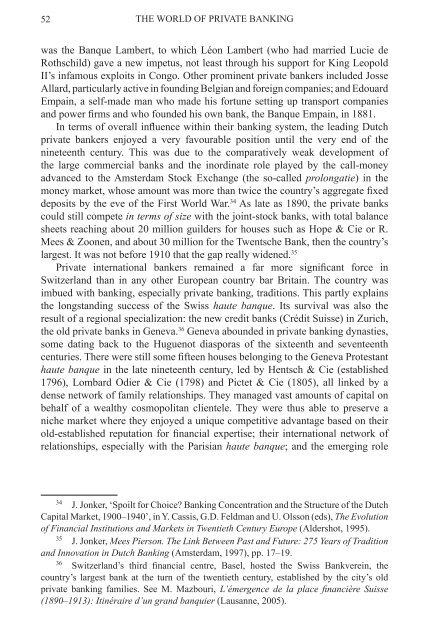the world of private banking
the world of private banking
the world of private banking
Create successful ePaper yourself
Turn your PDF publications into a flip-book with our unique Google optimized e-Paper software.
52<br />
THE WORLD OF PRIVAtE BANKING<br />
was <strong>the</strong> Banque Lambert, to which Léon Lambert (who had married Lucie de<br />
Rothschild) gave a new impetus, not least through his support for King Leopold<br />
II’s infamous exploits in Congo. O<strong>the</strong>r prominent <strong>private</strong> bankers included Josse<br />
Allard, particularly active in founding Belgian and foreign companies; and Edouard<br />
Empain, a self-made man who made his fortune setting up transport companies<br />
and power firms and who founded his own bank, <strong>the</strong> Banque Empain, in 1881.<br />
In terms <strong>of</strong> overall influence within <strong>the</strong>ir <strong>banking</strong> system, <strong>the</strong> leading Dutch<br />
<strong>private</strong> bankers enjoyed a very favourable position until <strong>the</strong> very end <strong>of</strong> <strong>the</strong><br />
nineteenth century. This was due to <strong>the</strong> comparatively weak development <strong>of</strong><br />
<strong>the</strong> large commercial banks and <strong>the</strong> inordinate role played by <strong>the</strong> call-money<br />
advanced to <strong>the</strong> Amsterdam Stock Exchange (<strong>the</strong> so-called prolongatie) in <strong>the</strong><br />
money market, whose amount was more than twice <strong>the</strong> country’s aggregate fixed<br />
deposits by <strong>the</strong> eve <strong>of</strong> <strong>the</strong> First World War. 34 As late as 1890, <strong>the</strong> <strong>private</strong> banks<br />
could still compete in terms <strong>of</strong> size with <strong>the</strong> joint-stock banks, with total balance<br />
sheets reaching about 20 million guilders for houses such as Hope & Cie or R.<br />
Mees & Zoonen, and about 30 million for <strong>the</strong> Twentsche Bank, <strong>the</strong>n <strong>the</strong> country’s<br />
largest. It was not before 1910 that <strong>the</strong> gap really widened. 35<br />
Private international bankers remained a far more significant force in<br />
Switzerland than in any o<strong>the</strong>r European country bar Britain. The country was<br />
imbued with <strong>banking</strong>, especially <strong>private</strong> <strong>banking</strong>, traditions. This partly explains<br />
<strong>the</strong> longstanding success <strong>of</strong> <strong>the</strong> Swiss haute banque. Its survival was also <strong>the</strong><br />
result <strong>of</strong> a regional specialization: <strong>the</strong> new credit banks (Crédit Suisse) in Zurich,<br />
<strong>the</strong> old <strong>private</strong> banks in Geneva. 36 Geneva abounded in <strong>private</strong> <strong>banking</strong> dynasties,<br />
some dating back to <strong>the</strong> Huguenot diasporas <strong>of</strong> <strong>the</strong> sixteenth and seventeenth<br />
centuries. There were still some fifteen houses belonging to <strong>the</strong> Geneva Protestant<br />
haute banque in <strong>the</strong> late nineteenth century, led by Hentsch & Cie (established<br />
1796), Lombard Odier & Cie (1798) and Pictet & Cie (1805), all linked by a<br />
dense network <strong>of</strong> family relationships. They managed vast amounts <strong>of</strong> capital on<br />
behalf <strong>of</strong> a wealthy cosmopolitan clientele. They were thus able to preserve a<br />
niche market where <strong>the</strong>y enjoyed a unique competitive advantage based on <strong>the</strong>ir<br />
old-established reputation for financial expertise; <strong>the</strong>ir international network <strong>of</strong><br />
relationships, especially with <strong>the</strong> Parisian haute banque; and <strong>the</strong> emerging role<br />
34<br />
J. Jonker, ‘Spoilt for Choice? Banking Concentration and <strong>the</strong> Structure <strong>of</strong> <strong>the</strong> Dutch<br />
Capital Market, 1900–1940’, in Y. Cassis, G.D. Feldman and U. Olsson (eds), The Evolution<br />
<strong>of</strong> Financial Institutions and Markets in Twentieth Century Europe (Aldershot, 1995).<br />
35<br />
J. Jonker, Mees Pierson. The Link Between Past and Future: 275 Years <strong>of</strong> Tradition<br />
and Innovation in Dutch Banking (Amsterdam, 1997), pp. 17–19.<br />
36<br />
Switzerland’s third financial centre, Basel, hosted <strong>the</strong> Swiss Bankverein, <strong>the</strong><br />
country’s largest bank at <strong>the</strong> turn <strong>of</strong> <strong>the</strong> twentieth century, established by <strong>the</strong> city’s old<br />
<strong>private</strong> <strong>banking</strong> families. See M. Mazbouri, L’émergence de la place financière Suisse<br />
(1890–1913): Itinéraire d’un grand banquier (Lausanne, 2005).












![[Pham_Sherisse]_Frommer's_Southeast_Asia(Book4You)](https://img.yumpu.com/38206466/1/166x260/pham-sherisse-frommers-southeast-asiabook4you.jpg?quality=85)



